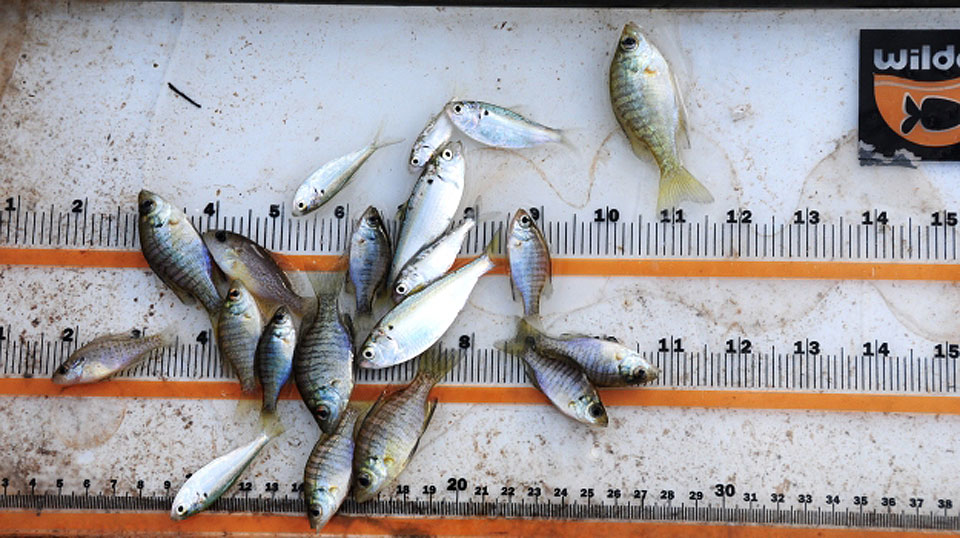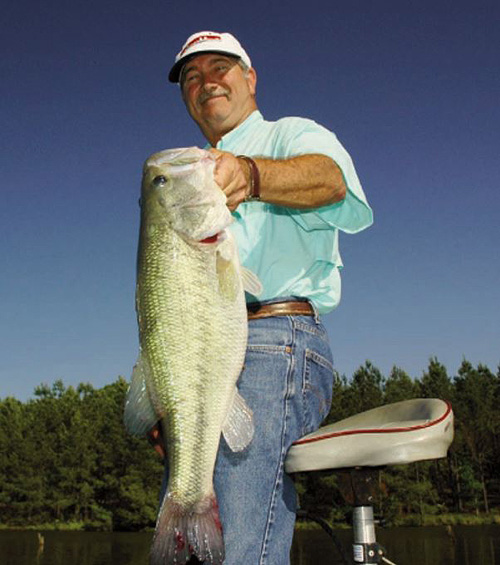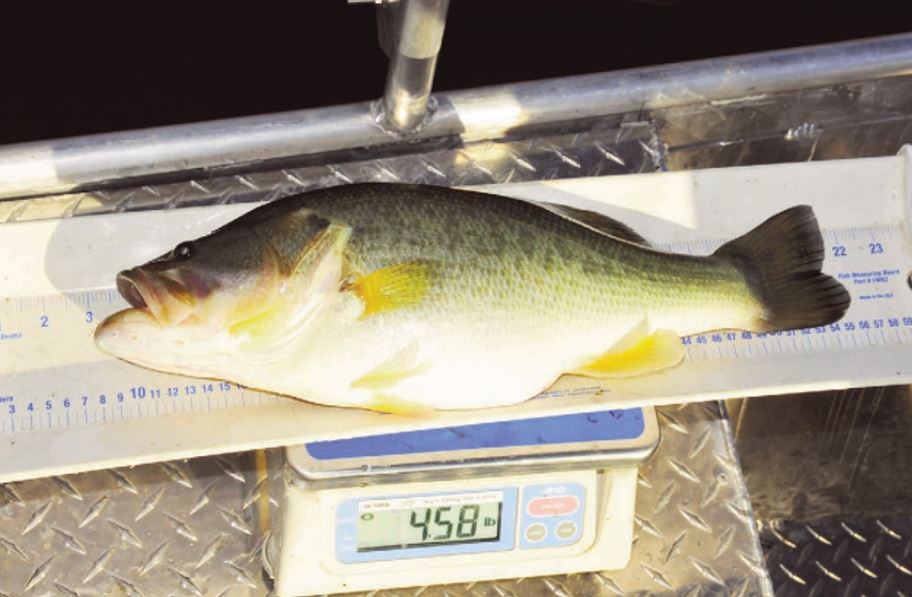Barry W. Smith | Originally published in GameKeepers: Farming for Wildlife Magazine. To subscribe, click here.
Tiger Bass® is a buzzword among pond owners and bass anglers throughout the Southeast. Word of its success has traveled overseas to such unlikely places as Japan and Italy. What is this fish, where does it come from, and what is the real scoop on its growth.

The name “Tiger Bass” is actually a registered trademark of American Sport Fish Hatchery in Montgomery, Alabama. This name refers to the specific cross developed at American Sport Fish, utilizing its strain of aggressive, pure northern largemouth bass bred with a strain of proven trophy Florida largemouth bass. The purpose of this particular breeding was to create a true F-1 bass that would be easy to catch and have a rapid growth rate. Private lake consultants from Georgia to Texas have distributed Tiger Bass from American Sport Fish to their clients.
The term F-1 is used in the scientific community to denote the offspring resulting from the mating of two different species, subspecies or genetic strains of animals. In this case, F-1 refers to the breeding of the two recognized subspecies of largemouth bass: Florida bass, Micropterus salmoides Floridanus, and the northern bass, Micropterus salmoides salmoides.
All F-1s are not created equal.
The F-1 utilized by state game and fish agencies during the 1960s and 1970s was a cross between a pure northern (native) bass and a pure Florida bass. This is not the same as the Tiger Bass, which was created through a selective breeding program to bite artificial lures more readily (aggressive northern strain), and to grow at a more rapid rate (offspring from trophy Florida bass blood lines). There are many so-called “F-1” bass available today, but most are merely an intergrade bass containing an unknown mixture of Florida and northern genetics. Buyers beware!
Growth Rates of Tiger Bass

uncommon in the Southeastern United States. Proper stocking and
management produces consistent results of trophy bass.
Today’s pond owners are certainly more knowledgeable regarding bass management than those of the 1970s. There has been considerable progress, especially among private sector biologists, regarding bass management in ponds. Thinking “outside the box” and challenging many of the paradigms of the 1950s and 1960s has yielded greater predictability in creating outstanding bass fisheries. Changing traditional bluegill-bass stocking from the traditional 10:1 to a 30:1 or even higher has resulted in consistent growth rates in excess of 2 pounds per year. There are also more pond management tools available to biologists and pond owners today than there were in the 70s. We have aeration and destratification systems, automatic fish feeders, liming barges, supplemental forage, such as threadfin shad, golden shiners and tilapia─ as well as an understanding of selective bass harvest. All of these factors contribute to the size and growth rate of bass and the number of trophy bass available to the lake owner.
Growth rates of any strain of largemouth bass are first limited by food. Most bass management experts agree that availability of proper size forage is the key to rapid growth for all bass. In well-managed lakes and ponds in the Southeast, Tiger Bass have shown consistent growth rates, often exceeding 2 pounds per year. The majority of these lakes are well fertilized and have both bluegill and threadfin shad as a forage base. There is an established pattern of exceptional growth from Georgia to Texas, where Tiger Bass are documented gaining 2.5 to 3 pounds per year.
During the fall of 2012 we electrofished a 30-acre lake where the 18-month-old Tiger Bass weights ranged from 2.5 to more than 4.5 pounds. The lake had been stocked at a 30:1 ratio of bluegill to bass and was also stocked with golden shiners and threadfin shad. The larger bass were all females.
We received a report from Mark Hardy of Columbus, Mississippi, stating he had caught numerous bass in his 20-acre lake this fall that were also 2.5 to 4 pounds. These Tiger Bass had been stocked for 18 months and also at a 20:1 stocking ratio.
Ben Dowling, fisheries biologist and owner of Southern Lake Management says, “We have had excellent growth from the Tiger Bass and almost unbelievable growth in some instances. Lake owners that are really good managers and who have ponds in good soil types can’t believe how fast their bass are growing. I have a client, Mr. Bobby Franks of Hale County, Ala., who caught a Tiger Bass that weighed 9 pounds, 12 ounces and was only 32 months old! It does not take long for good news to spread. He has a lake full of 7- to 10-pound bass.”
Mr. Glenn Bugsby of Baldwin County, Ala. reported catching up to four pound Tiger Bass in less than 18 months. The reports continue, as these lakes age, the bass get larger and are still growing at an average of two pounds per year. Bear Lake Fishing Club in Washington County, Ala. have had several bass over 14 pounds caught before the lake was seven years old.

“We have been very pleased with the Tiger Bass,” says Don Keller of American Sport Fish Hatchery. “It has performed well in both growth and catchability. Our clients are pleased, and that makes our life easier. It was always difficult to explain to clients why they could grow a trophy Florida bass and then couldn’t catch it on an artificial lure. We commonly see 1.5 to 2 pounds of growth each year and have seen some really big fish. Neil Schrimshire of Adventure Lake, near Laurel, Miss., had a client who caught a 13- pound, 4-ounce Tiger Bass that was only 5.5 years old. We had a client catch one of our first experimental Tiger bass that was almost 15 pounds in 8 years.
“Producing the Tiger Bass requires a lot of extra hatchery work,” continues Keller. “We place a radio transmitter in each of our brood bass to identify our two strains of bass and to distinguish males from females. It is worth the trouble, this is a great bass for private ponds,” says Keller, “and we have a long list of clients who are pleased with the aggressiveness of the Tiger Bass and its growth potential.” We will keep tracking the Tiger; a new state record may be lurking in your neighborhood.
Barry W. Smith is a Certified Fisheries Scientist and an internationally recognized expert on largemouth bass management in ponds and lakes. He has authored numerous publications on largemouth bass and was a speaker at both National Bass Symposia, which were sponsored by the American Fisheries Society. He is co-owner of American Sport Fish Hatchery (800-524-0383) with his partner, Don Keller.































